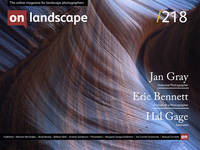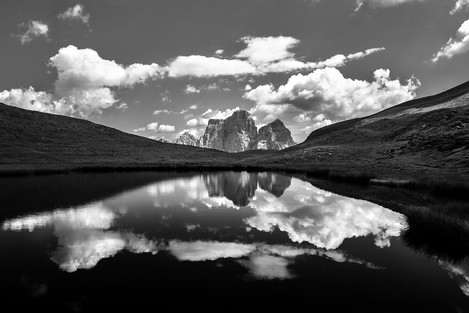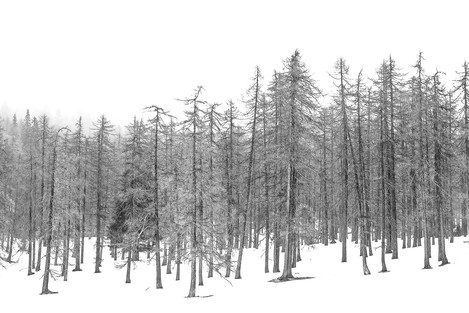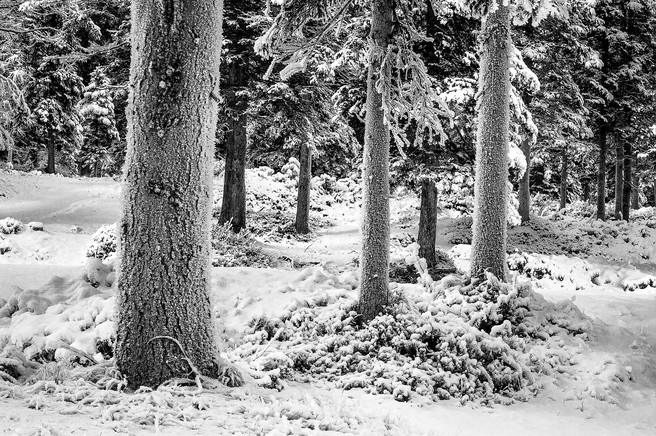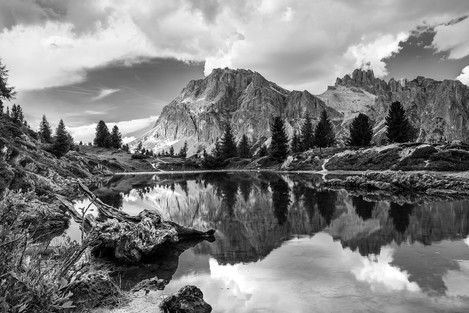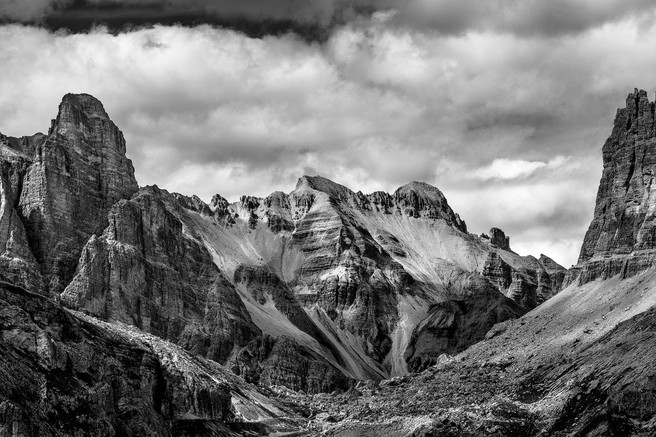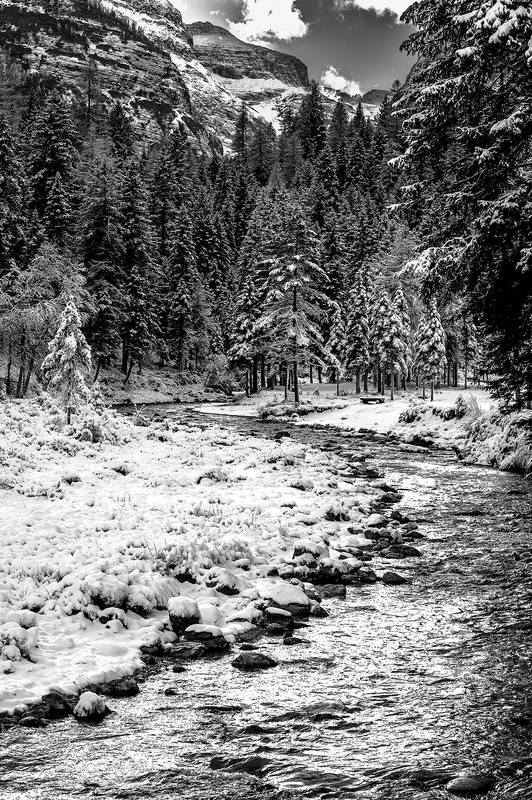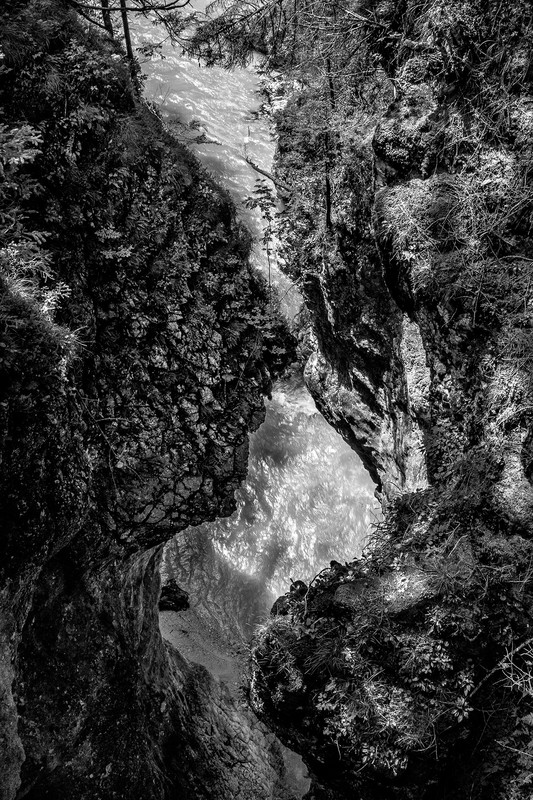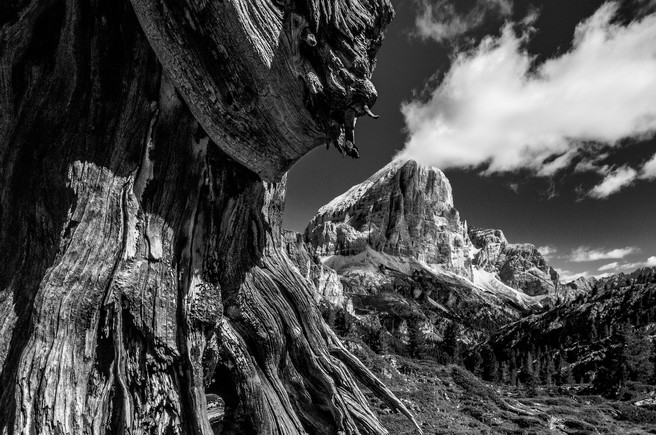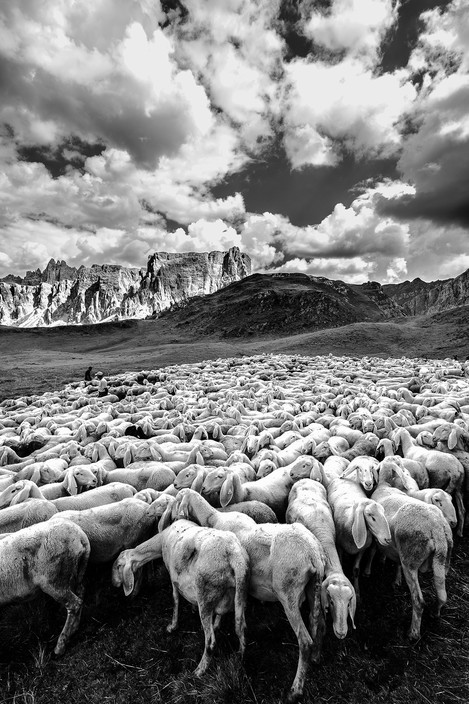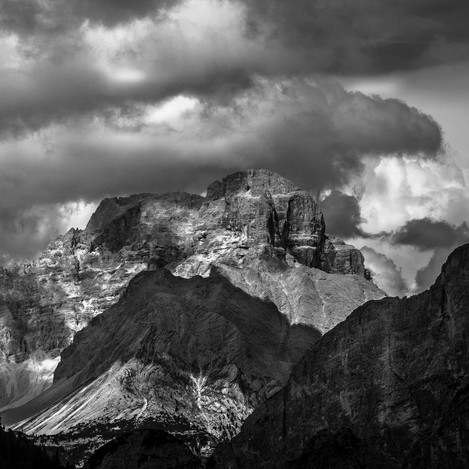An Interview with Manuel Cicchetti

Manuel Cicchetti
Manuel was born at the end of the 1960s and as a young boy he started taking pictures for passion, then as a job during University. At the beginning of the 90s he started working in the music industry for BMG, EMI and CNI companies designing some of their album covers.
Since 2001 he has followed the development of the foundation La Nuova Musica – Ricordi Music School, which today is one of the most important music educational realities in Italy and Europe. In 2011 he established the publishing house The Music Company and from 2014 he has got back to his roots and first love: photography.

Charlotte Parkin
Head of Marketing & Sub Editor for On Landscape. Dabble in digital photography, open water swimmer, cooking buff & yogi.
Back in May, during the first lockdown in the UK, Manuel Chicchetti contacted us about a book that he had just finishing called 'Monocrome | Walking through the Ampezzo Dolomites'. Browsing through the images really made me want to get out in the mountains around our home but that was met with the frustration that I couldn't as were we confined to our immediate area, with advice from the Mountain Rescue of not venturing up the mountains. The big vistas and views you get in the Dolomites are like no other and kept me inspired, so I started an email conversation with Manuel and enjoyed hearing about his project and his passion for the mountains.
What sparked your passion for photography?
It all arose from the education that my family chose for me; since before I was a schoolboy, they took me to museums, to art galleries and to visit the most iconic cities both in Italy and abroad. As I grew up, it felt natural for me to enter first the world of painting, and then later the world of photography.
Why did you choose landscape photography as opposed to other genres?
After working for twenty years according to the rhythms of a large metropolis – obviously a very stimulating environment, but also a frenetic one – I felt a need to slow down, to decompress. And therefore, to train my lens on something else; something that would accompany me on a slower journey, and landscapes are the most apt subject for that. I went back to looking at nature and at the environment. The choice is not exclusive, but today landscape photography occupies a very high place in my work.
Tell me about the photographers or artists that inspire you most. What books stimulated your interest in photography and who drove you forward, directly or indirectly, as you developed?
One of Ansel Adams’ famous quotes reads: “You don't make a photograph just with a camera. You bring to the act of photography all the pictures you have seen, the books you have read, the music you have heard, the people you have loved.” I believe that the great American photographer was absolutely right. I have studied a lot, attending exhibitions, buying books, reading and keeping publications: from August Sander, Tina Modotti, Robert Adams, Don Mc Cullin, Josef Kudelca, Richard Avedon, Robert Doisneau, Henri Cartier-Bresson to Luigi Ghirri, but these are just a few of them. I could list dozens, and they are all, in my opinion, among the greats. But it’s not just photography; film was key for me, from John Ford to Fellini to Luchino Visconti, as was theatre, which was the first area in which I gained regular employment as a photographer.
In 1999 the composer Filippo Del Corno asked you to realise the scenography and to be the director of the piece “On the high wire” by Philip Petit, with Marco Baliani and Michele Abbondanza, inside the renowned festival Cantiere Internazionale d’Arte in Montepulciano (SI) – Italy. How did you find that experience and about organising the project?
I have always thought that working with others has as its first consequence an increase in my knowledge and my sensitivity. Therefore, I have always loved and sought the mixing of different art forms. I felt lucky to have been chosen for this project; I would have to reckon with some of the masters, and I wasn’t even thirty years old, I wasn’t much more than a beginner. In the complexity of an event which included a great actor, a formidable dancer, a refined composer, a symphonic orchestra and a scenography made out of images projected onto multiple screens we managed to create a magical alchemy. Three things were key: great serenity, being able to listen to others and the freedom which derived from the first two.
You have a strong background in music, do you think there is a link between the visual medium of photography and the medium of music?
A young photographer just over twenty years old has to find areas to work in, and mine was music, to begin with. Images have always gone together with other art forms, and music is certainly no exception. You only have to think of the spine of many editions of the Divine Comedy, which depict the crooked nose of the greatest poet, Dante. Images have always been part of operas; you only have to think of the set designs. It is and always will be an inseparable union. Photography, which is just over 150 years old, has been and always will be an integral part of the musical medium together with videos.
You say in the book 'My story among these mountains starts early, I was just 3 months old, I moved my first steps right on these paths. I spent my life on these paths for nearly half a century, but I am, and always will be a foreigner, a “foresto” as they luckily call whoever is not from these places, whoever is not from Ampezzo" Have you always had a connection to these mountains? Do you think you saw the area differently as an ‘outsider’?
I am sure that the mountains of Ampezzo were the first place that I visited in my life, and for me, they represented a place of reunion for my family, who were divided between Milan and Bologna. I have always spent long periods in these mountains, weaving relationships with their inhabitants and oftentimes growing with them, but my formation remains urban. The only peaks I would see for the rest of the year were skyscrapers and the roofs of high-rise buildings. I never got used to the mountains to the point where I wouldn’t be surprised when I opened a window in the morning and saw forests of fir or larch trees and the Tofane or the Cristallo. Yes, I think that the term “foresto” is a correct way of describing me, but I don’t think that’s a bad thing; being surprised is a fantastic feeling.
Tell us a bit about the project 'Ampezzo Dolomites’. Where did the idea for the project start?
It seems incredible, but I had never photographed them. Yes, a few shots over the years, but these were largely of moments with family or friends. The theme was neither nature nor the Dolomites. One summer I considered paying back what these places had gifted me over so many years, and I thought about how to do that. It all started from the first frame that I would shoot the following year. That photo matured within me for twelve months. The rest came by itself over four years of work, with no rush.
How did the project evolve? Did you have to refine the vision of what you wanted to achieve?
I was clear on what story I wanted to tell and I was clear on how I should do it. I worked with “tilt&shift” architectural lenses; for me, these were no longer mountains, but sculptures, or stone architectural structures, or Renaissance paintings. I went back to everything I learned in my formation, especially as a boy, and I started shooting. All the seasons and all the natural elements would have to be present.
Was the choice of black and white photography a way of linking the project with the past?
No, I have always loved black and white photography, it was at the core of my formation. Many of the photographers I mentioned did not shoot in colour, whether because of age or because of choice. I chose to work by subtraction, eliminating colour, and I focused mainly on shapes.
Helping my work along, especially in this case, is nature; in the mountains the clouds change the lighting within a few minutes, altering the scenery at a rate that keeps you alert at all times.
Denis Curti writes in the book "There are three distinctive elements in the photographic project of Manuel Cicchetti: the strong feeling of belonging to a place, the unconditional love for nature and the need to translate his visions and feelings into clear images, full of harmonious development that can give back to the vision and contemplation a true meaning." How do you think you capture these emotions in your images? Is it something that you consciously think about or is it intuitive in your workflow?
At the basis of every shot, unless montaged like you can do in a studio, whether you are shooting a portrait, a building or a landscape, is a reading. For me it is essential to read the shapes that light draws on objects. The majority of the time the photograph is born before you pick up your camera. I think it’s my tendency towards observation that guides me, and that is born out of my curiosity.
Helping my work along, especially in this case, is nature; in the mountains the clouds change the lighting within a few minutes, altering the scenery at a rate that keeps you alert at all times.
How did you go about researching and deciding which mountains and landscapes to include in the book?
A deep knowledge of the land forms the basis of this work. The Ampezzo Dolomites are a very small territory of 370 km2, 24 times smaller than Yellowstone (8.913 km2).
What’s surprising is the concentration of extraordinary mountains, rock complexes, lakes and stretches of water, and forests that are enclosed within this one corner of Italy.
Tell us about how you planned the project, how long it took, how did you decide in which sequence you chose to visit the locations.
My planning process followed a study of the Ampezzo Dolomites National Park and of the seasons. I was in no rush; four years went by since the first shot. In the meantime, I finalised how to bring the project to fruition, I found a publisher, I built a very close team with a photo editor, a printer and a graphic designer, and I formed partnerships with local councils and organisations. Indeed, this book was followed by exhibitions in Milan, Cortina d’Ampezzo, Belluno, Turin, and – upcoming – Venice and Rome.
After I finished shooting, I chose to leave it up to the photo editor to build the sequencing of the book, and I think I made the right choice; I would have been too attached to the individual images to feel free to choose between them.
Were there any of the mountains that you found particularly challenging to photograph or were in interesting locations?
From a photography point of view there are, as always happens, people or places with whom you vibe more, and where everything comes more easily. I often went back to the same places again and again within a few days or months to shoot again in a different light, not because I wasn’t happy with the previous shot but to satisfy my curiosity.
Tell me what your favourite two or three photographs from the book are and a little bit about them (please include these images in the ones you send over)
Tricky question… I’m joking, but I don’t just have three!
Could you tell us a little about the cameras and lenses you typically take on a trip and how their choice affects your photography?
I work with both analogue and digital photography. For what concerns analogue photography I use:
- Large Format Camera
- Linhof Technikardan and Master Technika both 4x5
- With Schneider and Rodenstock optics
- Medium Format
- Hasselblad 500 CM
- With 40, 50, 80 and 150 Carl Zeiss-Hasselblad optics
- For digital medium format
- Fuji GFX 50 MP
- FUJINON GF63mmF2.8
- FUJINON GF120mm
- As for DSLR
- I shoot with a Nikon D5
- AF-S NIKKOR 14-24mm f/2.8G ED
- AF-S NIKKOR 24mm f/1.8G ED
- AF-S NIKKOR 28mm f/1.8G
- AF-S NIKKOR 50 mm f/1.8
- AF-S NIKKOR 70-200mm f/2.8G ED VR II
- PC-E NIKKOR 24mm f/3.5D ED
- PC-E NIKKOR 45mm f/2.8 ED
- PC-E Micro NIKKOR 85mm f/2.8D
What sort of post processing do you undertake on your pictures? Give me an idea of your workflow...
When working with digital photography the process involves two pieces of software, which I use depending on which camera I chose for the shot. They are Lightroom and CaptureOne. Then if the images are going to be printed a print file is prepared, having chosen Fine Art paper. I usually use Canson® Infinity Baryta Prestige 340g/m² for B&W prints such as those in the book.
For analogue photography I use Kodak or Ilford for the shot, depending on what I want to achieve. Then comes the development phase. But here the question becomes empirical as well as technical…
Did you start with the intention of making a book or did that idea follow later?
I knew from the first day that a book would be born out of this.
How did you manage the flow of the book with the images and the narrative?
I chose to work with a very good photo editor: Jacopo Anti.
Did you manage the project yourself or did you work with an editor?
In agreement with TCI Touring Club Italiano, who published the book, I chose to work with a photo editor, whom I picked because I feel that he is close to my own aesthetic.
How did you decide on the format of the book e.g. size and paper, print type?
I chose to work with a graphic designer and a printer. The graphic designer is Massimo Fiameni, who helped me choose the format and the paper. Then I worked with Mario Govino, the printer, who created the prints for the exhibitions, and with whom I adjusted the photographs for use in the offset printing of the book.
What is next for you? Where do you see your photography going in terms of subject and style?
In September, after the end of the Covid pandemic, which slowed down the publication, my second book will be released, which is centred upon VAIA, the cyclone which destroyed 14 million trees in Italy. It is a book born out of an exhibition organised for Belluno Council and for the Festival Oltre le Vette (Beyond the Peaks Festival) in October 2019. This project combines my pictures with short stories written by journalist and writer Angelo Miotto, and it will be translated into both English and Spanish.
Meanwhile, I am working on my third book, in which I change subjects, telling the story of all that man has built in order to sustain globalisation.
You can buy Manuel's book 'Monocrome | Walking through the Ampezzo Dolomites' from Amazon Italy or from LensCulture.
- Mondeval and Monte Pelmo (p.93)
- Mondeval and Monte Pelmo (p.93)
- Storm on Antelao ( p.150 )
- Trees in the thaw (p.103)
- Windy day and backlight on Averau and Croda Negra (p.83)
- Canyon over the river Boite (p.75)
- Old pine and Tofana di Rozes (p.101)
- 800 sheep at Passo Giau, transhumance (p.105)
- Light and shadow on the Croda Rossa (p.117)
- Baste Lake and Monte Pelmo (p.145)
- Frozen trees (p.161)
- Limedes Lake(p.165)
- Line of larch trees in the fog (p.118)
- Col del Bos (p 34)
- Winter light on the Rio Fanes ( p.39 )

